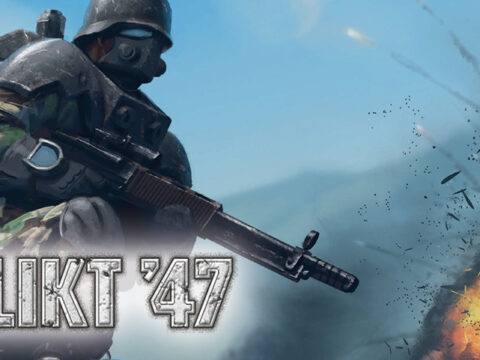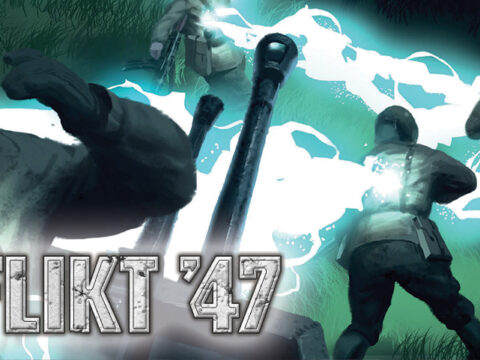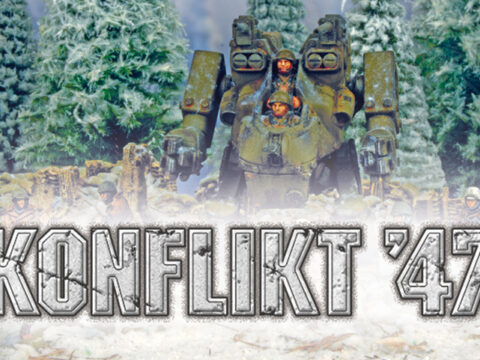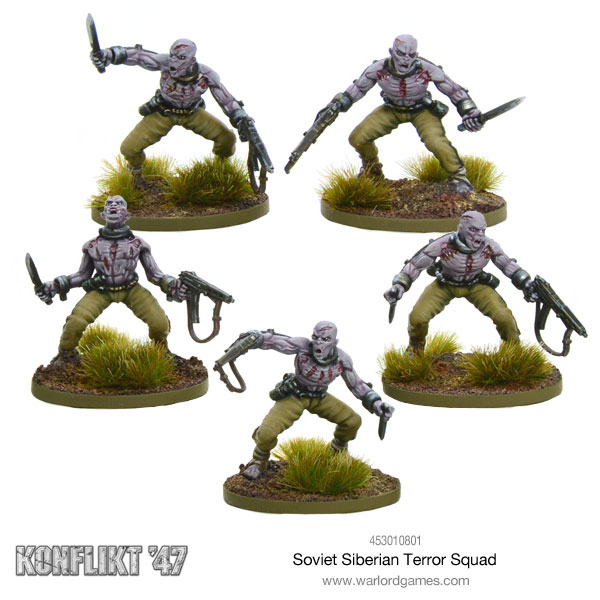Konflikt 47: Operation PIG-STICK and the Battle for Brussels
by Ben Moorhouse and Perry Bishop
PART I – BACKGROUND
Whilst tactically of little value, Brussels was a key political objective that the recapture of would have a stabilising effect on the Allied Coalition which was faltering in the wake of the German’s highly successful Case WATCH. Threatening to become the Stalingrad of the Western Front, the Allies needed a new Rift tech-inspired approach to clear the Brussels-Salient. Operation PIG-STICK, July to August 1945, would see the War’s largest deployment of walkers so far, with an Allied attempt to raid the city and capture the German Defender’s headquarters plunging them into command paralysis. Enter the 1st Allied Battle Walker Division and Major Cameron Templeton’s elite Claymore Squadron.
Operation WATCH and NEWPORT – The Stage for Brussels is Set
Following the German Army’s devastatingly successful counter-offensive, Case WATCH, Supreme Headquarters Allied Expeditionary Force (SHAEF) spent the early part of the spring of 1945 licking its wounds. The Wehrmacht had rapidly exploited along the boundary between the US and British Armies and had penetrated deep into the Allied rear area. Allied formations, who had been briefed by their commanders that the German’s were a broken force, had crumbled into a panic in the wake of technologically advanced Spinne light panzermechs by day and horrifying Shrekwulfen hunters by night. A general retreat was ordered by General Eisenhower. Had it not been for the immediate recall of veteran Allied Divisions refitting and recuperating in France, the retreat would have become a rout and the Allied Armies would have been split by the Germans from the Rhine to the Atlantic Coast.
The butcher’s bill from Operation WATCH was significant. Tactically, huge Allied logistics hubs had been captured by rapidly advancing German armoured columns, key Allied main supply routes had been severed and several Allied Divisions were so badly depleted of much-needed manpower that they had to be disbanded. Low Allied morale sank even lower due to a German propaganda campaign which had been integrated into their offensive. This messaging promised Allied soldiers that even more-powerful and more-advanced German “wunder” weapons were yet to be revealed. Strategically, the situation was even worse. Whilst the successes of the Operation allowed the Germans to consolidate men and material in the Ruhr valley, the Allies had already committed their equipment and manpower reserve to a renewed Italian campaign. Worst still, Brussels had been recaptured by the Germans with almost no resistance from the fleeing Allied armies. Politically this threw the Alliance into turmoil, with European politicians claiming that the US and Great Britain had its own agenda and cared little for the freedom of the smaller European states. With the Soviet Union now an enemy, it took all of Winston Churchill’s diplomatic reserves to hold the Alliance together and suppress the political manoeuvres of Soviet-funded communistic lobby groups. Whilst its physical-strategic value was limited, Brussels had to be recaptured to hold the faltering Alliance together.
Under pressure of being removed from post by meddling politicians, with his career and the Coalition at stake, Eisenhower gave his staff four weeks to produce a plan that would reverse the recent German gains. What resulted was Operation NEWPORT, a plan that would see the Allies using the Wehrmacht’s own Op WATCH operational plan against it. NEWPORT called for reinforced armoured columns to penetrate the German lines left and right of the Brussels salient, exploiting inter-Divisional boundaries and attempting to encircle German formations by cutting off their internal lines of communication. Central to this plan was the wide-scale deployment of tesla-armed Sherman and heavy armoured infantry that promised unrivalled-firepower and previously-unseen levels of protection. In execution, Operational NEWPORT was successful; large swaths of the Benelux region were recaptured, however, the costs in terms of Allied lives was high. Eisenhower’s staff had been overconfident in the impact that these new Rift technologies would have, particularly when Allied soldiers had only had been given four weeks to integrate them into existing tactical procedures. Worse still, Hitler, watching his Armies’ achievements during Operation WATCH unravelling, ordered the Rift-powered fortification of Brussels. One of the 3rd Reich’s last remaining prizes was to become a fortress city and defended to the last man. The Todt Organisation (a Third Reich Civil and Military Engineering) set to work and 3 Divisions of the German 7th and 5th Armies dug-in, deliberately falling into the trap of the Allied encirclement. The stage was set for one of the most destructive battles on the Western Front.
Festung Brussels and the Minefields of the Dead
On Hitler’s personal order’s, Albert Speer the Head of Organisation Todt, set to work in constructing “Festung Brussels”. Short of resources, and even shorter of time, it was clear that a conventional defence plan and obstacle belt would simply not be ready in time to counter any Allied offensive. Priorities instead focused on defeating the Allies’ superiority in airpower and armour, as well as attriting the Allied ground units through high-causalities. Neither the US, Great Britain or the Commonwealth Nations could afford another needless waste of life like Operation NEWPORT. The “honour” of the responsibility for the German Defence had been awarded to General de Panzertruppe Erich Brandenberger. A veteran Bavarian Artilleryman, who had shown a talent for the integration of ground fires on the Eastern Front. Using civilian forced labour roadblocks, barricades and anti-tank ditches were built in the city around German defensive hardpoints and bunkers cunningly built into the basements of reinforced buildings. Brandenberger was sure that fighting in-and-amongst the complex urban terrain would nullify the Allied’s superiority in armour and firepower. Key to Brandenberger’s plan was the largest deployment of the Die Totenkorps to date. Entire city blocks were declared “Totes Minenfeld” – literally “Dead Minefield”; zones of the city, integrated within the German Defensive plan, had been laced with thousands of Die Totenkorps to form a living, or rather, dead-barrier to the Allies’ advance through the City. Based upon British ULTRA reporting, the 3rd Reich’s entire Die Totenkorps reserve had been deployed, allegedly forcing the Germans to rapidly “recycle” allied and even civilian corpses.
Operation PIG-STICK and the Creation of 1st Allied Battle Walker Division
For SHAEF, these intelligence reports were particularly worrisome; the Allies couldn’t afford Brussels to become the Stalingrad of the Western Front. Any conventional assault on the City would cost the lives of thousands of men as they would be set upon by Die Totenkorps and then cut down by the integrated fires of the German defenders. The deployment of another atomic bomb was also entirely out of the question for fear of opening another rift so close to Germany. For a solution to overcome this significant obstacle once again the Allied turned to the master Engineer of D-Day, Major General Sir Percy Hobart. Now the British Military Attaché to the American Rift-tech programme, Sir Percy, proposed a concentrated deployment of the Allied Walker Fleet. Under the cover of a huge 1000 bomber raid that would cut a path through the city (Operation PIG). Meanwhile, a Walker strike force would blitz its way up the path created by the bombers to secure Brandenberger’s Headquarters that Resistance intelligence had located in the Hotel de Ville within the City Centre (Operation STICK). SHAEF’s hope was that by unexpectedly eliminating German command and control, the remainder of the three cut-off Divisions would quickly surrender.
1st Allied Battle Walker Division, commanded by Maj General Robert Urquhart, was hastily assembled, drafting the best volunteers from across the Commonwealth Nations. Comprising of 8th British Light Walker Brigade and the 52nd US Armoured Walker Brigade the “Hell Knights”, the force had very little time to train and there was significant debate on what doctrine the division should deploy. Urquhart, an airborne soldier and light-infantier by trade, won the debate and proposed that the Coyote, Jackal and Guardian light walkers should rapidly skirmish forward, working in sections of four, with fire support being providing by the much larger and more capable Grizzly walkers. In the shaping phase of the battle, the heavy bombers of the RAF and US Air Force would fix the German Defenders in place whilst the largest concentration of Allied Artillery ever seen would fire a smoke screen to conceal the 1st Allied Battle Walker Division’s advance. The light walkers would easily clear through the Die Totenkorps minefields and the Grizzlies could breach any main German Defensive positions, allowing the British Guards Division to follow on behind, echelon-through and accept the surrender of Brandenberger’s Headquarters.
The “Hell Knights” Enter the City
The morning of the 5 August 1945 should have begun like any other for the men of the 9th Panzer Division who were defending the Grimbergen sector of the City’s defences. Comfortably billeted in middle-class housing stock, they slept soundly in their beds assuming they were well-protected by a 5km deep defensive line of wire, anti-tank ditches, pillboxes and flocks of walking dead. For the last few evenings, Wehrmacht clearance patrols in the 5th Army’s sector had reported increased Allied logistics movements and motor traffic. Brandenberger’s Headquarters assumed that this intelligence indicated that the Allies were conducting a relief-in-place of their line, in order for an offensive to be delivered elsewhere along the front. Regardless, a cautious technocrat, the General order his Army Group reserve, several SS panzermech battalions, to increased levels of readiness. At 5am, just as the first field kitchens were being lit, the northern edge of the city was suddenly plunged into fire – manmade daylight courtesy of the Allied aviation armada and two army-groups worth of heavy artillery.
1st Allied Battle Walker Division’s plan was for 52nd US Armoured Walker Brigade to rapidly advance along a north-to-south axis which had been cleared by the overwhelming bombardment. They would exploit through the huge open parkland surrounding the, secure a crossing over the Charleroi Canal, and then 8th British Light Walker Brigade would push through, supported by heavy armoured columns, to secure the city centre and the prize of Brandenberger’s command bunker, thus putting the German defenders into command paralysis. Indeed, the 52nd Brigade’s early gains were impressive as the German’s had been caught completely off guard. Many of the defenders had assumed it was simply another bomber raid headed for Berlin and remained in their beds. Subsequently, these men were forced to flee at the sight of the massed rapidly-advancing Allied light walkers bypassing their positions. Many of the outflanked defenders were forced into their own undead minefield defensives. The little-organised resistance that was offered was quickly neutralised by heavy firepower from Allied Grizzly walkers. By 1100am the American’s had secured the Chateau de Laeken, however, the vital bridging equipment needed to cross the canal was delayed. The Allied bridging train had been nearly overwhelmed by a massive Die Totenkorps hoard that had broken free from their holdings in the preliminary bombardment and was now ravaging the 1st Division’s rear area.
It was late afternoon by the time the bridging assets had reached the Charleroi Canal, and with the long warm summer evening ahead of them, the engineers began to hastily build a walker-capable crossing. It was clear that Operation STICK was faltering. With the air and artillery cover of Operation PIG gone, as well as the element of surprise lost, Urquhart saw the importance of rapidly securing a bridgehead and consolidating his force in order to force a march to the city centre. However, he had underestimated the recovery speed of the German Defending Headquarters as well as the mobility of the German reserve. Brandenberger quickly concentrated his reserve SS panzermech battalions for an immediate counter-attack. Cunningly dispersed and concealed, ULTRA and Allied Intelligence knew nothing of their presence in Brussels. Urquhart, blind to the threat of the SS panzermech battalions, ordered his Division’s elite recce formation to force a crossing and maintain the momentum of advance. Urquhart knew that his Claymore Squadron, commanded by a fellow Scotsman, Major Cameron Templeton, could well make the difference in this difficult situation. Templeton, a former disgraced Special Operations Executive operative who was well-known for his tenacity in both the offense and defence, had a handpicked team of veteran warriors from Highlander and Airborne units. With their walkers proudly emblazoned with tartan-insignia, they were the first Allied unit to cross the canal. Claymore Squadron moved into a hasty defensive position in a warehouse complex on the far bank ready to cover the advance of Urquhart’s main force. Less than 250 metres away three Kompanies of Spinne Light Panzermech were forming up into assault order ready to strike the crossing. A bloodbath along the canal and the first large-scale walker-on-walker tactical action of the war was about to ensue…
Starter Sets to get started!
The best approach to get into Konflikt’47 is to find your army of choice a pick up a starter set. Each is focussed on a specific army and provides the basic requirements for any force plus the rules. Then, on top of these sets, you’ll easily be able to expand with the many options, which are being added to all the time, in the Konflikt’47 collection…
German Starter Set:
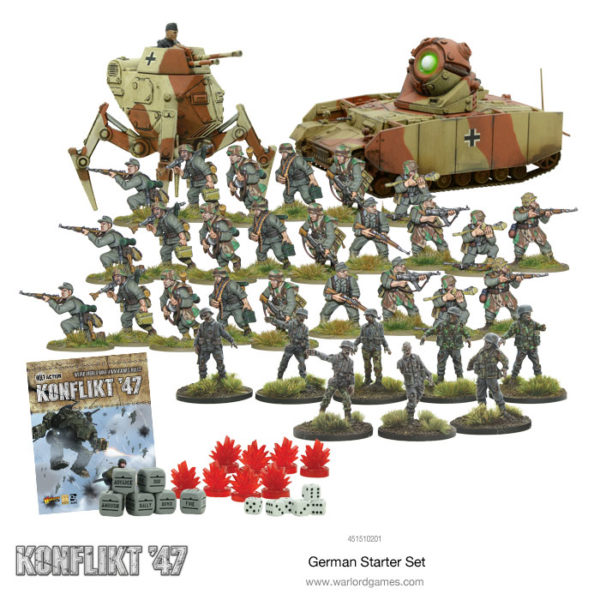
Soviet Starter Set:
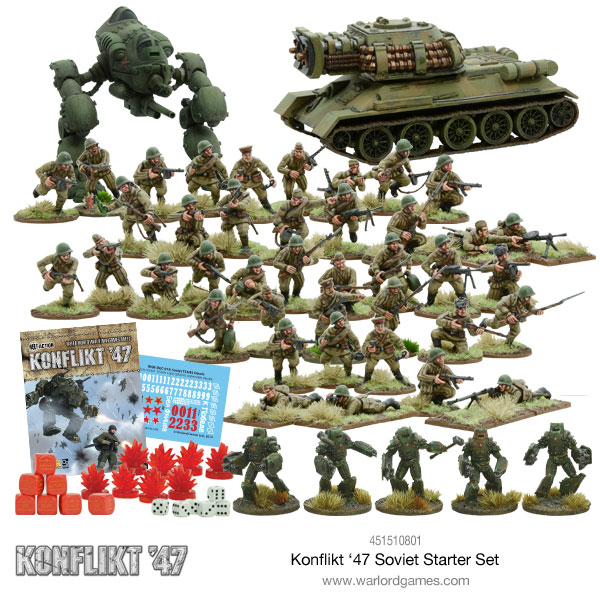
British Starter Set:
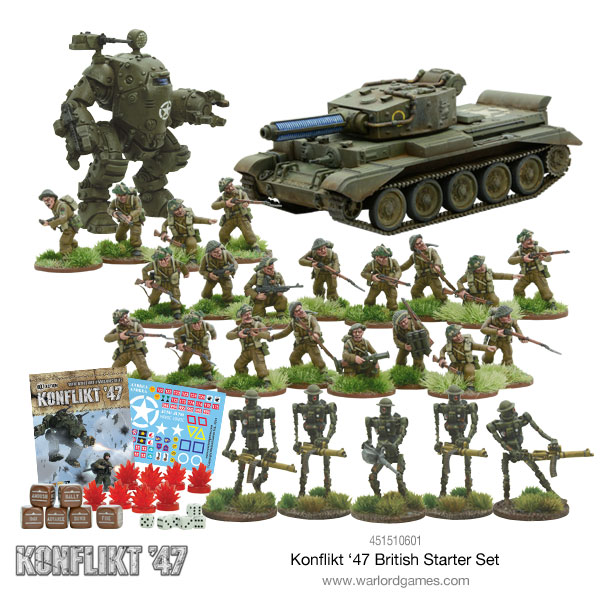
US Starter Set:
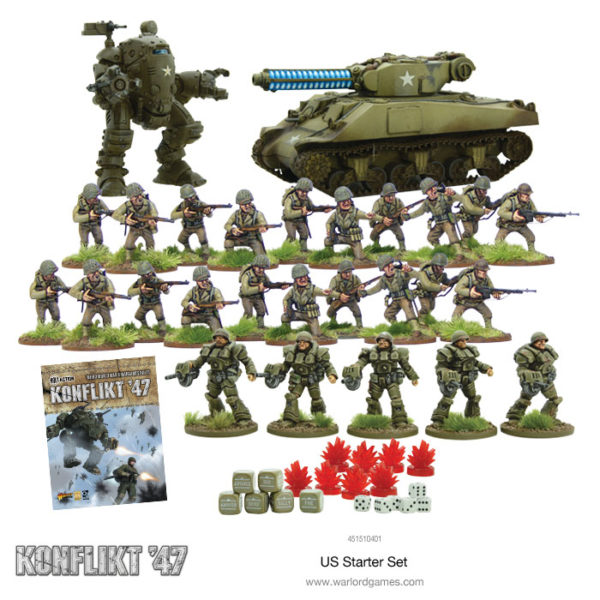
Japanese Starter Set:
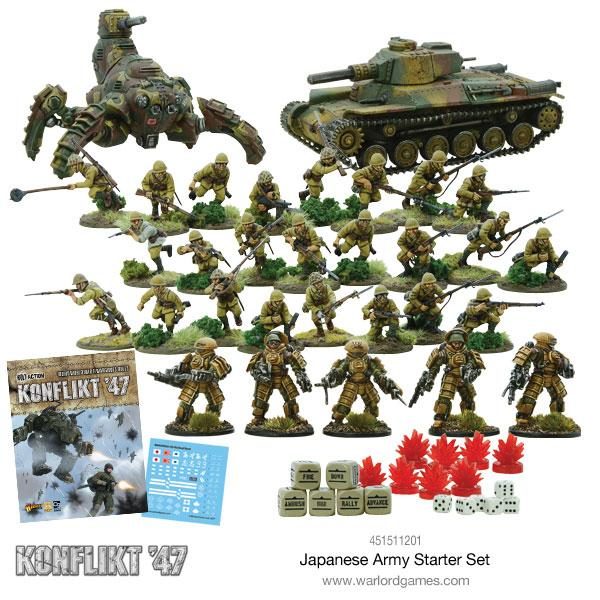
Finnish Starter Set:
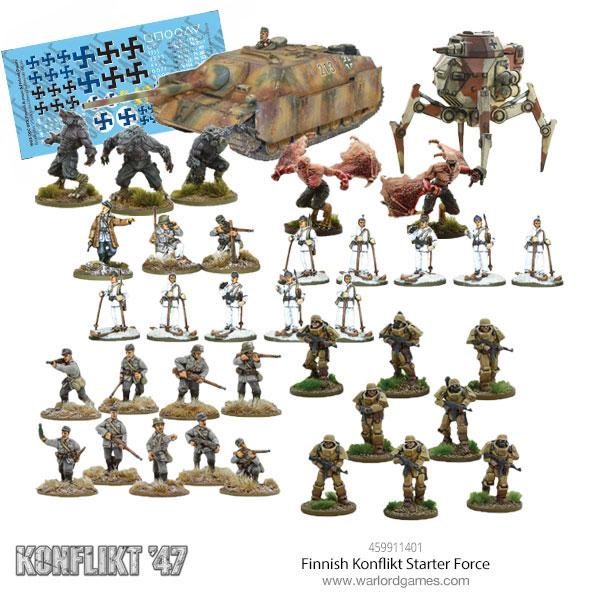
So onward commander, choose your force and see if you will prevail on as World War II continues into 1947 and beyond!
Do you have an article within you? Are you itching to show your collection to the world? Then drop us a line with a couple of pictures to info@warlordgames.com or share with all over at the Warlord Facebook page






